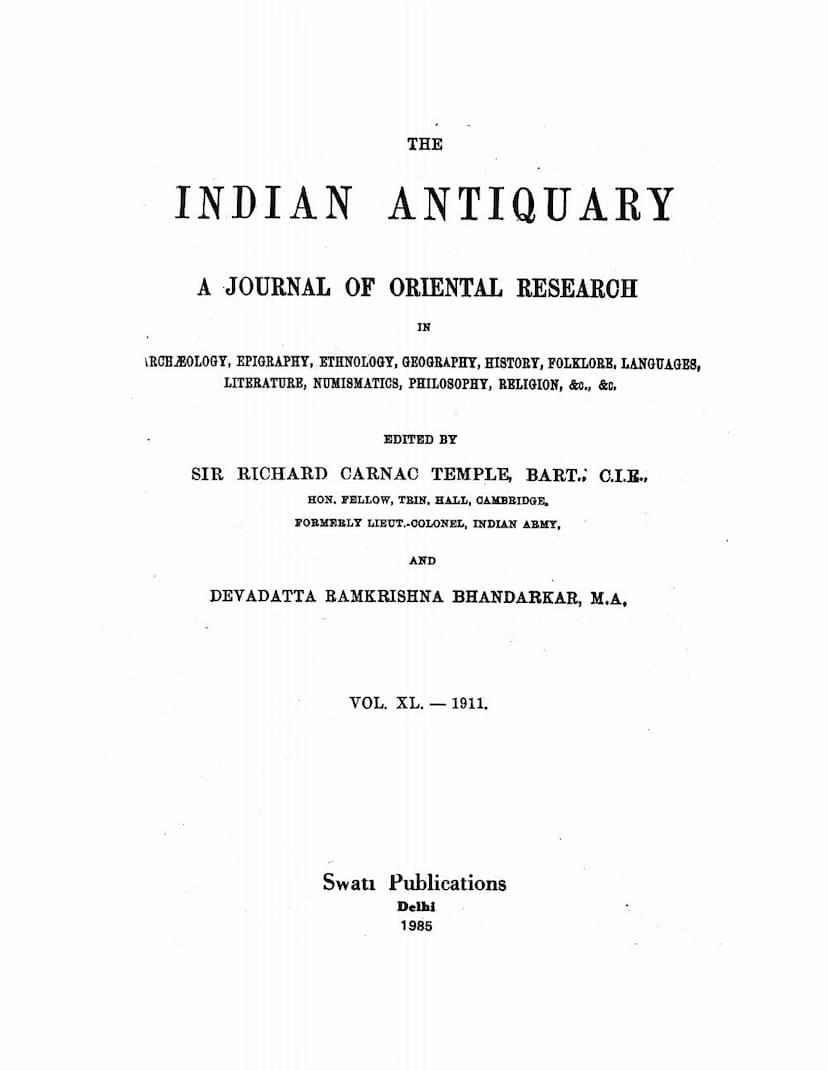Indian Antiquary Vol 40
Added to library: September 1, 2025

Summary
This volume of the Indian Antiquary, published in 1911, edited by Sir Richard Carnac Temple and Devadatta Ramkrishna Bhandarkar, is a collection of scholarly articles on various aspects of Oriental research. While the title of the volume is "Indian Antiquary Vol 40," the primary focus for this summary is on the articles related to Jainism, or those that mention Jainism within broader religious or historical contexts.
Key Articles and Themes Related to Jainism:
-
"Jaina Iconography" by D. R. Bhandarkar, M.A.: This is a significant article for understanding Jainism within the context of Indian art and religious history. The author discusses the Samavasarana, a key concept in Jainism representing the divine assembly where Tirthankaras deliver their sermons. Bhandarkar details the structure of the Samavasarana as described in Jain texts, including its ramparts, gateways, attendant deities, and the symbolic representations within. He also notes the presence of Samavasarana sculptures in Jain temples and the possible variations in their depiction. The article also touches upon the identification of Jinas with certain Hindu deities and the interplay between Brahmanical and Jain iconography.
-
"Foreign Elements in the Hindu Population" by D. R. Bhandarkar, M.A.: While primarily a study of the incorporation of foreign tribes into Hindu society, this article makes a passing mention of Jainism in the context of the decline of Buddhism and Jainism in Southern India. It discusses how these religions co-existed and interacted with Hinduism, and how their decline might have been influenced by factors like the rise of Saivism and Vaishnavism, and the withdrawal of royal patronage.
-
"The Date of Maduraikkanchi and its Hero" by K. V. Subrahmanya Aiyar, B.A.: This article, while focusing on a Sangam period Tamil work, mentions the presence of Jaina teachers and their influence in Southern India, particularly in the Pandya country and the Madura district. It notes that the Pallava king Mahendravarman was an avowed Jaina in the earlier part of his reign and that several early Rashtrakuta kings were also Jainas. The article points to the persecution of other religions by some rulers as a potential cause for the decline of Jainism. It also highlights the contributions of prominent Jaina teachers like Samantabhadra, Akalanka, Vidyananda, and Jinasena to Jaina literature and philosophy.
-
"A Comparative Grammar of Dravidian Languages" by K. V. Subbayya, M.A., L.T., M.R.A.S.: In this linguistic analysis, the author touches upon the influence of Brahmanical religious polity on the Bhotiyas and their adoption of customs that may have led to the disappearance of polyandry. While not directly about Jainism, it offers a comparative linguistic perspective relevant to cultural interactions in South India.
-
"The Kailasa Temple at Elura" by D. R. Bhandarkar, M.A.: This article discusses the history and dating of the magnificent Kailasa Temple at Elora. It mentions that the temple was built by Krishnaraja I of the Rashtrakuta dynasty and that some of the Rashtrakuta kings were staunch Jainas. The article highlights the intermingling of religious influences in Southern India, where Jainism and Buddhism co-existed with Brahmanism.
-
"The Date of Maduraikkanchi and its Hero" by K. V. Subrahmanya Aiyar, B.A.: This article mentions that the rise of the Lingayat or Virasaiva creed in the 12th century A.D. contributed to the decline of Jainism in the Kanarese country.
-
"The Origin and Decline of Buddhism and Jainism in Southern India" by K. V. Subrahmanya Aiyar, B.A.: This is a crucial article that directly addresses the history of Jainism in Southern India. It details the influence of Jaina teachers like Samantabhadra, Akalanka, Vidyananda, and Jinasena, and mentions the patronage of Jainism by several South Indian dynasties, including the Pallavas, Pandyas, Western Chalukyas, Gangas, and Rashtrakutas. It also notes instances of persecution of other religions by some Jaina rulers. The article discusses the decline of Jainism, attributing it to the waning of royal support and the rise of Saiva and Vaishnava reformers, particularly the influence of figures like Nanasambanda, Appar, Sundaramurti, and Sankaracharya. It also highlights the contributions of Jaina saints to Tamil literature and the existence of numerous Jaina temples and monks in various districts.
Overall Context:
This volume of the Indian Antiquary reflects the scholarly approach of the early 20th century to Oriental studies. The articles related to Jainism, particularly Bhandarkar's work on Jaina Iconography, are foundational in their attempt to systematically document and analyze Jain religious practices and artistic representations. The discussions on the interaction of Jainism with other religious and political forces in South India provide valuable context for understanding the historical development of religious landscape in the region. The inclusion of philological and historical analyses by various scholars demonstrates the interdisciplinary nature of the research conducted at the time.